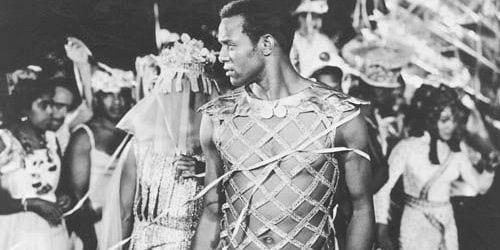
The wildly colorful and propulsive scenes of Carnival in and around the favelas (shantytowns) of Rio de Janeiro, and the lilting and lovely bossa nova music, along with its intensely rhythmic predecessor, samba, are probably the factors that made Marcel Camus’ Black Orpheus such a sensation when it was released back in 1959. In that predominantly black-and-white era in America (a bit of a cliché, but not without some truth), this “exotic” and often excessively frenetic movie, with its swirling costumes and impossibly energetic dancing, must have felt to moviegoers of that era like a quick trip to Brazil after a long, hard winter.
Black Orpheus is a retelling of the myth of Orpheus and Eurydice with, as its title would suggest, an all-black cast, but its adherence to the original story is something less than classically correct. More or less as in the myth, the movie’s male protagonist, Orpheus, is said by the children of the favela to be able to make the sun rise with his guitar playing, and after his new love, a beautiful and naïve visitor named Eurydice, is murdered by her former lover attired in the guise of Death, Orpheus travels to the “underworld” – in this case, a morgue – in an attempt to revive her.
Black Orpheus won the Academy Award for Best Foreign Language Film, and also captured the Palme d’Or at Cannes, but in truth, it doesn’t hold up quite as well as its reputation might suggest.
Part of the problem is that the story has little emotional resonance, because Orpheus has just met Eurydice, and in fact has just abandoned his equally lovely, if somewhat grating, new fiance for her. As a result, we never get to see what Orpheus and Eurydice see in each other, beyond their physical beauty and the mythical coincidence of their names (which the movie directly acknowledges.) At the same time, the relationship between Eurydice and the Death figure that hunts her through the swarming Carnival throngs is sketchy and exists almost entirely on the level of symbol.
The movie’s depiction of the favela and its inhabitants also is lacking. The story switches from a mode of pure joy, as the residents prepare for the long-awaited Carnival, and legendary despair, when Death inevitably strikes. But death, in the lower-case sense, and hunger, and crime, and the whole malodorous truth of what life in a Brazilian hillside slum without running water or sewage systems must have been like, is hidden behind the painstakingly crafted masks and Technicolor-ready costumes.
The point is not that the movies must deal with slum-dwellers in an exclusively sociological context or by taking a joyless and admonitory tone – only that, in this case, the movie plummets from the pure happiness of a sun-splashed hillside to the dolor of a Brazilian morgue with no sense whatsoever that anything exists in between.
The movie’s lack of subtlety is exemplifed by its soundtrack. Viewing the extra-free DVD re-release from Janus Films (as part of its Essential Art House series), it’s striking how little bossa nova, that infinitely gentle music, the film actually contains. Instead, Black Orpheus is dominated by percussive scenes of slum-dwellers dancing frantically, as if possessed, to the rhythms of samba.
These scenes are exciting, but go on endlessly, and with little creativity in the manner in which they were shot and edited. The brief moments of samba’s more harmonically sophisticated and jazz-influenced offshoot function, by contrast, like a cool breeze: The bits of “Manha de Carnaval” we hear at the beginning of the movie are a reminder that this is one of the loveliest and saddest of all bossa nova melodies.
This is mostly a matter of taste: Plenty of people prefer samba, which in any event is more appropriate to the movie’s Carnival setting, to the bossa nova. But the lack of contemplative moments in this film, and its wild plunge from unalloyed happiness to tragedy, is simply a mistake.
As Orpheus sings at one point (the words, in English translation, are taken from the subtitles), “Sadness has no end. Happiness does. Happiness is like a drop of dew on a flower’s petal, brilliant and tranquil, then quivering, then falling like a tear of love.”
More moments like this, where the movie and the viewer alike are suspended in that misty and indeterminate region between happiness and something indefinably sad, would have turned this fleetingly bright movie into an indelibly memorable one. Instead, as colorful as it may be, Black Orpheus ends up being something of a black-and-white movie, after all.

![Call for Papers: All Things Reconsidered [MUSIC] May-August 2024](https://www.popmatters.com/wp-content/uploads/2024/04/all-things-reconsidered-call-music-may-2024-720x380.jpg)



